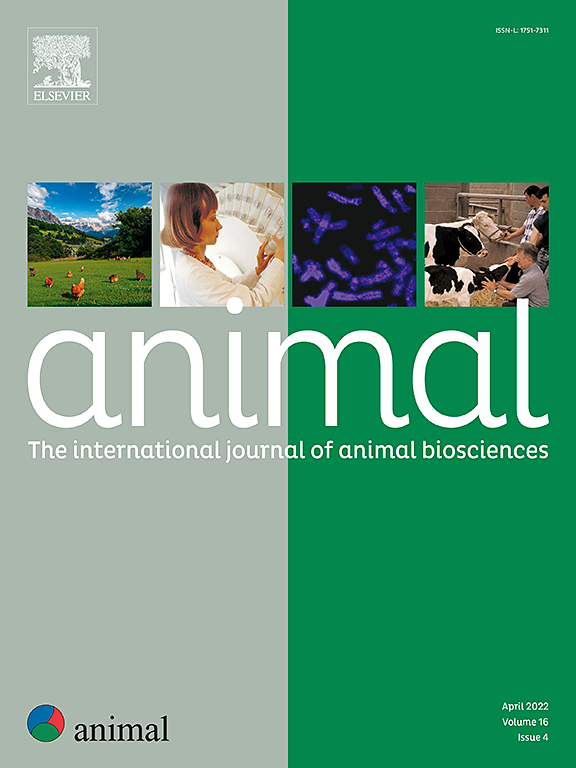Effects of phosphorus and calcium depletion on growth performances and bone mineralisation in growing pigs
IF 4
2区 农林科学
Q1 AGRICULTURE, DAIRY & ANIMAL SCIENCE
引用次数: 0
Abstract
The use of P nowadays is raising environmental (eutrophication) and sustainability (limited resource) concerns in the swine industry, but initial trials have shown that similar growth performance can be achieved between pigs fed on a requirement basis and those fed using a P depletion-repletion strategy. To optimise the use of dietary P by pigs, three feeding strategies were studied according to a 3-phase feeding programme: (1) C–C–C providing 100% of the P and Ca requirements, (2) C-LNormal-C, providing 100% of the P and Ca requirements in phases 1 and 3 (C) with a depletion in phase 2 with 60% of the P requirements combined with a normal Ca:digP ratio of 2.6 (LNormal), and 3) C-LHigh-C, providing 100% of the P and Ca requirements in phases 1 and 3 (C) with a depletion in phase 2 with 60% of the P requirements combined with a high Ca:digP ratio of 3.3 (LHigh). Bone mineral content (BMC) and BW were measured at the beginning and end of each phase. BMC gain, average daily gain, average daily feed intake and feed efficiency were calculated for each phase. In phase 1, all pigs received the same diet. At the end of phase 2, the C-LNormal-C and C-LHigh-C groups had similar BMCs compared to the C–C–C group. Finally, at the end of phase 3, the BMC gain was numerically higher in the C-LNormal-C group than in the C–C–C group (25.4 vs 18.7 g/d, P = 0.10). Although depletion did not cause a decrease in BMC in the C-LNormal-C and C-LHigh-C groups (versus C–C–C), it did result in better P use during repletion. These results demonstrate the value of a depletion-repletion strategy to reduce P intake and excretion without compromising the final performance.
磷和钙缺失对生长猪生长性能和骨骼矿化的影响
如今,P 的使用引起了养猪业对环境(富营养化)和可持续发展(资源有限)的关注,但初步试验表明,按需要量饲喂的猪和采用 P 消耗-补充策略饲喂的猪可以获得相似的生长性能。为了优化猪对日粮中 P 的利用,研究人员按照三阶段饲喂方案对三种饲喂策略进行了研究:(1)C-C-C,提供 100% 的 P 和 Ca 需求量;(2)C-LNormal-C,在第一和第三阶段提供 100% 的 P 和 Ca 需求量(C),在第二阶段消耗 60% 的 P 需求量,结合正常的 Ca:digP 比率 2.6(LNormal-C);(3)C-LNormal-C,在第一和第三阶段提供 100% 的 P 和 Ca 需求量(C),在第二阶段消耗 60% 的 P 需求量,结合正常的 Ca:digP 比率 2.6(LNormal-C)。6(LNormal),以及 3) C-LHigh-C,提供第 1 和第 3 阶段(C)100% 的 P 和 Ca 需求量,第 2 阶段消耗 60% 的 P 需求量,Ca:digP 比值高达 3.3(LHigh)。在每个阶段开始和结束时测量骨矿物质含量(BMC)和体重。计算每个阶段的骨矿物质增重、平均日增重、平均日采食量和饲料效率。在第 1 阶段,所有猪都食用相同的日粮。在第二阶段结束时,C-LNormal-C 组和 C-LHigh-C 组的 BMC 与 C-C-C 组相似。最后,在第 3 阶段结束时,C-LNormal-C 组的 BMC 增重在数量上高于 C-C-C 组(25.4 克/天 vs 18.7 克/天,P = 0.10)。尽管耗竭并没有导致 C-LNormal-C 组和 C-LHigh-C 组(与 C-C-C 组相比)的 BMC 下降,但在补给过程中却能更好地利用 P。这些结果证明了消耗-补充策略的价值,即在不影响最终成绩的情况下减少 P 的摄入和排泄。
本文章由计算机程序翻译,如有差异,请以英文原文为准。
求助全文
约1分钟内获得全文
求助全文
来源期刊

Animal
农林科学-奶制品与动物科学
CiteScore
7.50
自引率
2.80%
发文量
246
审稿时长
3 months
期刊介绍:
Editorial board
animal attracts the best research in animal biology and animal systems from across the spectrum of the agricultural, biomedical, and environmental sciences. It is the central element in an exciting collaboration between the British Society of Animal Science (BSAS), Institut National de la Recherche Agronomique (INRA) and the European Federation of Animal Science (EAAP) and represents a merging of three scientific journals: Animal Science; Animal Research; Reproduction, Nutrition, Development. animal publishes original cutting-edge research, ''hot'' topics and horizon-scanning reviews on animal-related aspects of the life sciences at the molecular, cellular, organ, whole animal and production system levels. The main subject areas include: breeding and genetics; nutrition; physiology and functional biology of systems; behaviour, health and welfare; farming systems, environmental impact and climate change; product quality, human health and well-being. Animal models and papers dealing with the integration of research between these topics and their impact on the environment and people are particularly welcome.
 求助内容:
求助内容: 应助结果提醒方式:
应助结果提醒方式:


